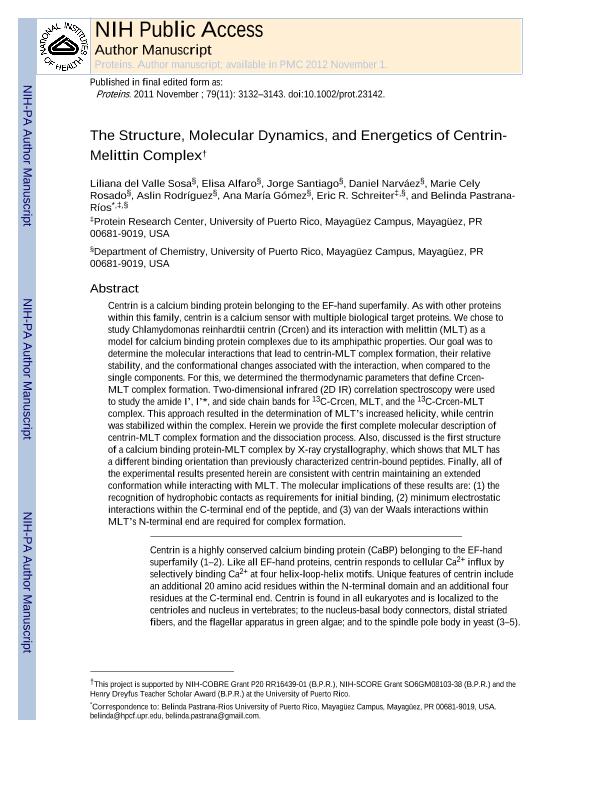Artículo
The structure, molecular dynamics, and energetics of centrin-melittin complex
Sosa, Liliana del Valle ; Alfaro, Elisa Raquel; Santiago, Jorge Fernando; Narváez, Daniel; Rosado, Marie Cely; Rodríguez, Aslin; Gómez, Ana María; Schreiter, Eric R.; Pastrana Ríos, Belinda
; Alfaro, Elisa Raquel; Santiago, Jorge Fernando; Narváez, Daniel; Rosado, Marie Cely; Rodríguez, Aslin; Gómez, Ana María; Schreiter, Eric R.; Pastrana Ríos, Belinda
 ; Alfaro, Elisa Raquel; Santiago, Jorge Fernando; Narváez, Daniel; Rosado, Marie Cely; Rodríguez, Aslin; Gómez, Ana María; Schreiter, Eric R.; Pastrana Ríos, Belinda
; Alfaro, Elisa Raquel; Santiago, Jorge Fernando; Narváez, Daniel; Rosado, Marie Cely; Rodríguez, Aslin; Gómez, Ana María; Schreiter, Eric R.; Pastrana Ríos, Belinda
Fecha de publicación:
02/08/2011
Editorial:
Wiley-liss, div John Wiley & Sons Inc.
Revista:
Proteins: Structure, Function And Genetics
ISSN:
0887-3585
e-ISSN:
1097-0134
Idioma:
Inglés
Tipo de recurso:
Artículo publicado
Clasificación temática:
Resumen
Centrin is a calcium binding protein (CaBP) belonging to the EF-hand superfamily. As with other proteins within this family, centrin is a calcium sensor with multiple biological target proteins. We chose to study Chlamydomonas reinhardtii centrin (Crcen) and its interaction with melittin (MLT) as a model for CaBP complexes due to its amphipathic properties. Our goal was to determine the molecular interactions that lead to centrin-MLT complex formation, their relative stability, and the conformational changes associated with the interaction, when compared to the single components. For this, we determined the thermodynamic parameters that define Crcen-MLT complex formation. Two-dimensional infrared (2D IR) correlation spectroscopy were used to study the amide I', I'*, and side chain bands for 13C-Crcen, MLT, and the 13C-Crcen-MLT complex. This approach resulted in the determination of MLT's increased helicity, while centrin was stabilized within the complex. Herein we provide the first complete molecular description of centrin-MLT complex formation and the dissociation process. Also, discussed is the first structure of a CaBP-MLT complex by X-ray crystallography, which shows that MLT has a different binding orientation than previously characterized centrin-bound peptides. Finally, all of the experimental results presented herein are consistent with centrin maintaining an extended conformation while interacting with MLT. The molecular implications of these results are: (1) the recognition of hydrophobic contacts as requirements for initial binding, (2) minimum electrostatic interactions within the C-terminal end of the peptide, and (3) van der Waals interactions within MLTs N-terminal end are required for complex formation.
Archivos asociados
Licencia
Identificadores
Colecciones
Articulos(CCT - CORDOBA)
Articulos de CTRO.CIENTIFICO TECNOL.CONICET - CORDOBA
Articulos de CTRO.CIENTIFICO TECNOL.CONICET - CORDOBA
Citación
Sosa, Liliana del Valle; Alfaro, Elisa Raquel; Santiago, Jorge Fernando; Narváez, Daniel; Rosado, Marie Cely; et al.; The structure, molecular dynamics, and energetics of centrin-melittin complex; Wiley-liss, div John Wiley & Sons Inc.; Proteins: Structure, Function And Genetics; 79; 11; 2-8-2011; 3132-3143
Compartir
Altmétricas



